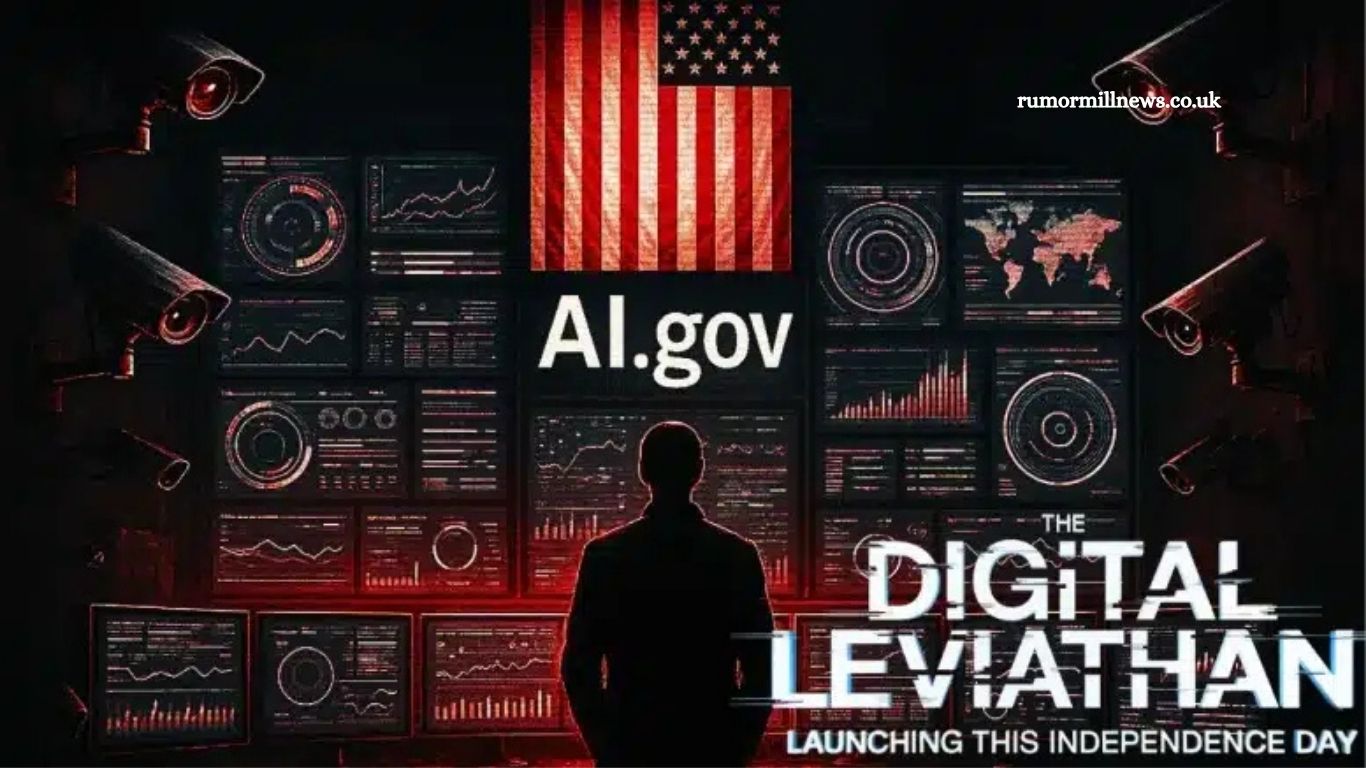AI.gov, set to launch this Independence Day, marks a significant step forward in the future of government and artificial intelligence. Positioned as a centralized digital infrastructure, AI.gov aims to revolutionize how public services operate by integrating advanced AI systems into federal operations. From real-time data analysis to predictive policy-making, this initiative promises increased efficiency, transparency, and citizen engagement.
Dubbed the “Digital Leviathan,” AI.gov embodies the power and complexity of AI-driven governance. As the U.S. embraces this technological leap, AI.gov is poised to redefine the relationship between citizens and the state in the age of intelligent automation and digital sovereignty.
The Silent Coup in Plain Sight
America stands at the edge of a historic transformation—one more perilous than any since the nation’s founding. While public attention remains fixated on partisan drama, a deeper, more insidious shift has taken root behind closed doors in Silicon Valley and Washington.
On July 4, 2025—just sixteen days away—the Trump administration is set to launch AI.gov, a centralized artificial intelligence command hub, signaling the rise of digital authoritarianism. This isn’t speculation. Verified leaks from government sources confirm the reality of this looming system. What follows will reshape your understanding of freedom, power, and human agency in the age of AI.
Read More: America Pillaged: The Rise of Oligarch Power
The Leaked Blueprint for Algorithmic Authoritarianism
The secrecy around AI.gov was shattered when 404 Media researchers uncovered a public GitHub repository containing its complete project blueprint. Before officials could react, the complete architecture of America’s technocratic future was exposed for all to see.
Far more than just a new government website, AI.gov is a centralized platform that grants federal agencies extensive powers to monitor, analyze, and influence digital activity. Its infrastructure already supports expansion beyond internal operations. At its core lies what can only be described as the “Trinity of Technocratic Control”—three integrated systems designed to reshape digital governance.
The AI Chatbot Assistant
Promoted as a tool to “streamline research, problem-solving, and strategy,” this AI chatbot replaces human judgment with algorithmic decision-making. By eliminating the “messy unpredictability” of people, it delivers the illusion of efficiency while quietly undermining democratic processes.
Unified API Framework: Centralized AI Control
This system links all federal agencies to AI models from OpenAI, Google, Anthropic, Amazon, and Meta. It centralizes control of AI integration across government—from defense to healthcare—creating a single, powerful gateway to influence public systems.
CONSOLE: Real-Time AI Surveillance
The most unsettling piece, Console, monitors AI usage across agencies in real-time. It tracks employee tools, analyzes performance, and lets managers “optimize resources.” In reality, it’s workplace surveillance masked as productivity data.
The Technocratic Vanguard: Meet Your New Overlords

Every revolution has its architects, and AI.gov is no exception. At the helm is Thomas Shedd, a former Tesla software integration engineer, who was appointed in January 2025 to lead the GSA’s Technology Transformation Services (TTS). His role marks more than a leadership change—it reflects a shift in how government sees its role in citizens’ lives.
Aligned with Elon Musk and pushing an “AI-first strategy,” Shedd envisions the GSA operating “like a software startup.” This language reveals a technocratic mindset that treats governance as a system to optimize, rather than a democratic process shaped by human judgment and consent.
Since Shedd’s arrival, TTS has reduced its workforce by 50%. Far from being a simple cost-saving measure, this move accelerates the replacement of human labor with algorithms, framed as “efficiency,” but effectively sidelining human agency from federal operations.
The Infrastructure of Digital Tyranny
Understanding AI.gov’s potential impact requires examining its technical foundation. The platform runs primarily on FedRAMP-certified systems, with most AI models delivered via Amazon Bedrock. While this certification ensures compliance and security, it also limits operations to pre-approved models within a tightly controlled environment.
Yet leaked documents reveal troubling exceptions. The inclusion of Cohere’s models—despite lacking FedRAMP certification—indicates that officials are bypassing security standards to accelerate deployment. This risky shortcut exposes sensitive government data, prioritizing speed over safety in the pursuit of a broader technocratic agenda.
We stand at a historic crossroads. This isn’t a choice between efficiency and inefficiency—it’s a choice between human agency and algorithmic rule, between a Constitutional Republic and an algocracy.
Demands for Resistance
Transparency: All AI.gov algorithms must be fully accessible for public review.
Human Oversight: No AI decision should bypass human judgment; clear appeal processes are essential.
Cognitive Liberty Zones: Federal employees must have protected, surveillance-free spaces for communication and thought.
The Philosophical War: Technocracy vs. Constitutional Republic
To understand why AI.gov poses an existential threat, we must confront the clash between technocracy and the foundations of a constitutional republic. This isn’t a routine policy dispute—it’s a conflict between two incompatible systems of power and governance.
Basis of Authority
Technocracy grants authority to unelected experts—engineers, scientists, and data analysts—who prioritize optimization over representation.
A Constitutional Republic rests on the consent of the governed. Power flows from citizens through elected representatives, constrained by law and guided by public will.
Decision-Making
Technocrats use data and algorithms to automate decisions, often sidelining debate, consent, or human judgment.
In a republic, decision-making is slow by design, requiring deliberation, compromise, and accountability to voters.
Role of the Individual
Technocracy treats individuals as system components—valued for efficiency, not agency.
A republic prioritizes individual rights over systemic goals, ensuring that each citizen has a voice.
Accountability
Technocrats answer to internal hierarchies, not the public. Their legitimacy is based on credentials, not elections.
Elected officials face regular public scrutiny and must answer to laws, courts, and the electorate.
Governing Philosophy
Technocracy frames society as a machine, best run by experts who solve problems through optimization.
A republic views society as a living, moral entity that balances competing values within a stable constitutional framework.
At its core, technocracy replaces political choice with technical control. It may function within a republic, but over time, it erodes its principles, concentrating power in the hands of unelected elites and weakening the rule of law.
A 1937 issue of Technocrat Magazine made this vision explicit:
“Technocracy is the science of social engineering… There will be no place for Politics or Politicians, Finance or Financiers, Rackets or Racketeers.”
Technocracy’s advocates argued that abundance and pricing are incompatible, and that proper distribution requires removing the price system altogether. Citizens wouldn’t vote or buy, but receive “distribution certificates” issued from birth to death.
This “American Plan,” they said, would replace democracy with scientifically managed control over the entire continent. In this system, efficiency reigns, and human sovereignty fades.
As Patrick Wood, author of Technocracy: The Hard Road to World Order, warns, technocracy offers cold, calculated governance—driven by data, devoid of consent.
The CONSOLE Effect
When people know they’re being watched, they self-censor, adjusting behavior and speech to avoid triggering surveillance. This effect, well-documented in corporate settings, will now spread across the entire federal workforce under AI.gov.
Shoshana Zuboff, in The Age of Surveillance Capitalism, explains howthe constanta extractionof data reshapes human consciousness. Individuals become “behavioral futures markets”—raw data to be mined and manipulated. AI.gov doesn’t just enable this reality—it codifies it into federal infrastructure.
Global Context: Digital Authoritarianism Goes Mainstream

China’s social credit system and the EU’s proposed AI Act highlight a troubling trend: authoritarian and democratic states are converging in their use of AI for population control. Even the U.S. Department of Homeland Security now deploys AI surveillance on “soft targets” like shopping malls, normalizing constant monitoring in public spaces.
The Path Forward: Reclaiming Human Agency
We stand at a historic crossroads. This isn’t a choice between efficiency and inefficiency—it’s a choice between human agency and algorithmic rule, between a Constitutional Republic and an algocracy.
Demands for Resistance
- Transparency: All AI.gov algorithms must be fully accessible for public review.
- Human Oversight: No AI decision should bypass human judgment; clear appeal processes are essential.
- Cognitive Liberty Zones: Federal employees must have protected, surveillance-free spaces for communication and thought.
Frequently Asked Questions
What is AI.gov?
AI.gov is a federal initiative designed to centralize artificial intelligence infrastructure across U.S. government agencies. It integrates AI systems from major tech firms like OpenAI, Amazon, Google, and Meta to automate operations, data analysis, and decision-making within public institutions.
Why is AI.gov controversial?
Critics argue that AI.gov signals a shift toward technocracy—governance by unelected experts and algorithms—undermining democratic principles, transparency, and public accountability. It also raises concerns about surveillance, data privacy, and the erosion of human agency in government.
Who is leading AI.gov?
Thomas Shedd, a former Tesla software engineer, was appointed to head the GSA’s Technology Transformation Services (TTS) in 2025. He has outlined an “AI-first strategy” to run government like a tech startup, triggering major structural and workforce changes.
How does AI.gov affect federal employees?
Under AI.gov, many federal positions are being replaced by algorithmic systems. Surveillance tools such as CONSOLE monitor employee behavior in real time, prompting fears of self-censorship, psychological pressure, and diminished workplace freedoms.
What are the security concerns?
Leaked documents reveal that AI.gov uses models from vendors without required FedRAMP certifications, such as Cohere, bypassing established cybersecurity standards. This raises risks of data breaches and unauthorized AI access to sensitive government information.
Is this similar to China’s social credit system?
While not identical, AI.gov shares characteristics with China’s system—centralized data, real-time monitoring, and predictive behavior control. The U.S. Department of Homeland Security already uses AI to monitor “soft targets,” reflecting a broader global trend.
Conclusion
AI.gov is not just a technological upgrade—it’s a redefinition of power. Beneath the promises of efficiency and innovation lies a deeper threat: the erosion of democratic control, constitutional safeguards, and individual agency. As unelected algorithms begin to govern public life, we risk entering an era where decision-making is automated, dissent is monitored, and liberty is quietly traded for optimization.
This is not a debate about progress vs. tradition. It is a choice between governance rooted in the will of the people and control imposed by machines and their makers. The rise of a digital bureaucracy—an algocracy—demands immediate public scrutiny, legal resistance, and moral clarity.



